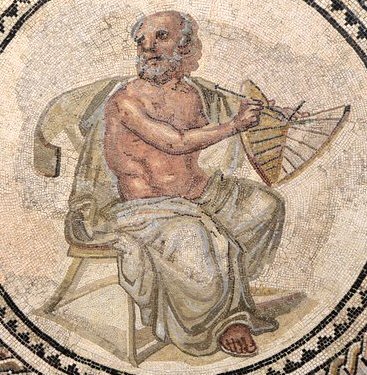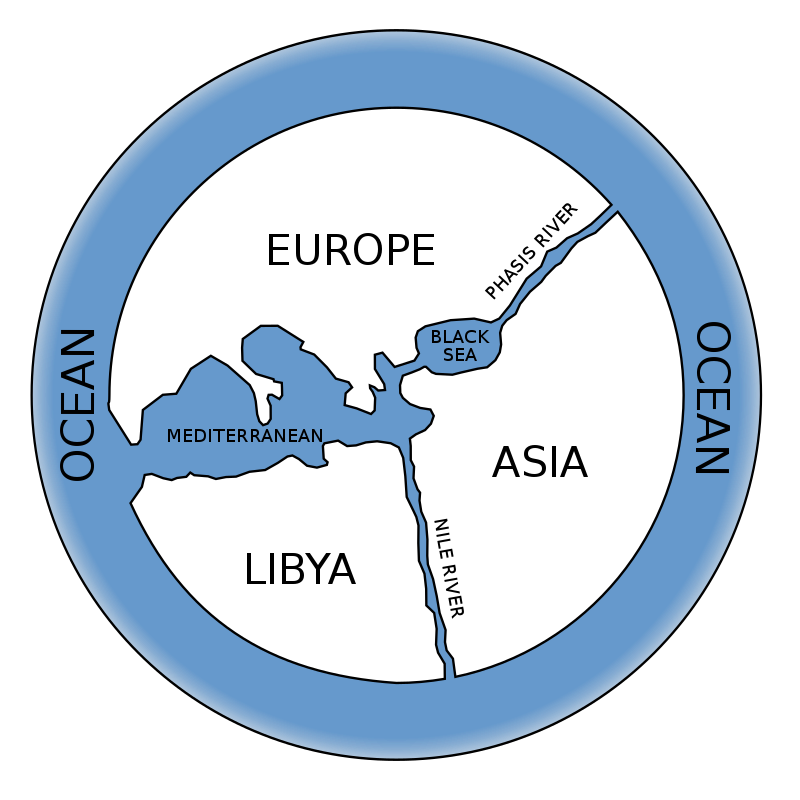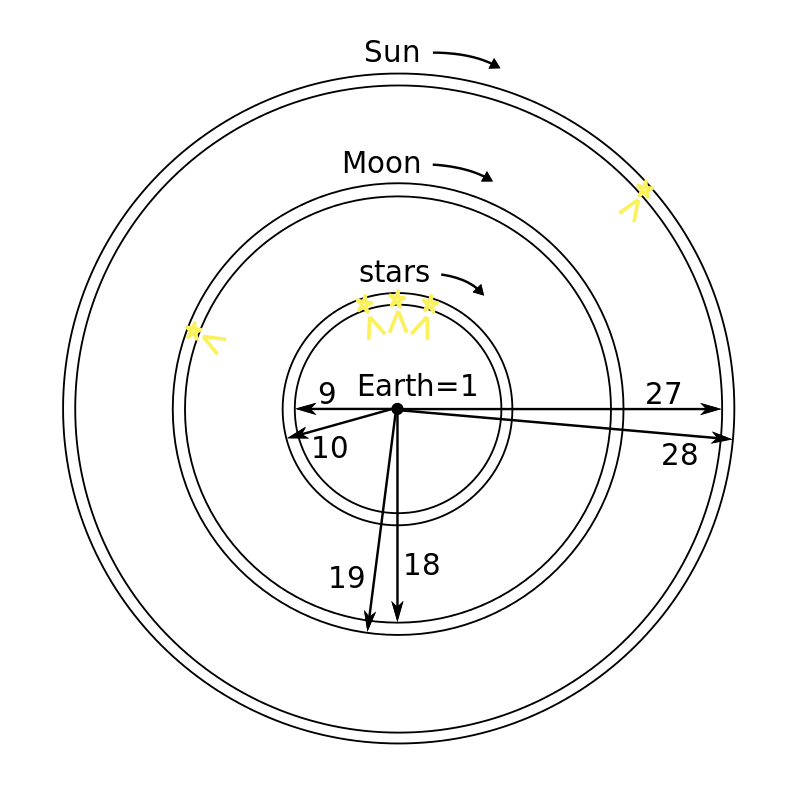
The ancient Greek thinker Anaximander, who was born in the third year of the 42nd Olympiad, or 610 BC, and who lived until c. 546 BC, was a polymath, lending his prodigious talents to the realms of pre-Socratic Greek philosophy, geography, geometry, cosmology, and politics.
He lived in Miletus, a city in Ionia, and belonged to the Milesian school, learning from his master, Thales of Miletus. He succeeded Thales to become the second master of that school where he counted Anaximenes and possibly the great mathematician Pythagoras amongst his pupils.
Although little of his life and work is known today, the effect of it is very far-reaching since he is the first philosopher known to have recorded his studies. Although only one fragment of his work remains, testimonies found in other documents after his death provide a portrait of the great man, who used rational thought to find his way through problems.
Anaximander tried to observe and explain different aspects of the universe, with a particular interest in its origins, claiming that nature is ruled by laws, just like human societies, and anything that disturbs the balance of nature does not last long.
Like so many thinkers of his time, Anaximander’s philosophy represented his far-ranging mind, and his life’s work included contributions across many disciplines. In astronomy, he attempted to describe the mechanics of celestial bodies in relation to the Earth.
He created a map of the world that contributed greatly to the advancement of geography, one which would form the basis of that used by later geographers and historians.
He was also involved in the politics of Miletus and was sent as a leader to one of its colonies. The third-century Roman rhetorician Aelian depicts Anaximander as leader of the Milesian colony to Apollonia on the Black Sea coast; some have inferred that he was therefore a very prominent citizen.
It is very likely that leaders of Miletus sent him there as a legislator to create a constitution or simply to maintain the colony’s allegiance.
In Lacedaemon, he participated in the construction, or at least in the adjustment, of sundials to indicate solstices and equinoxes. In his time, the gnomon used in the center of a sundial was simply a vertical pillar or rod mounted on a horizontal plane. The position of its shadow on the plane indicated the time of day.

As it moves through its apparent course, the Sun draws a curve with the tip of the projected shadow, which is shortest at noon, when pointing due south.
The variation in the tip’s position at noon indicates the solar time and the seasons; the shadow is longest on the winter solstice and shortest on the summer solstice.
As the Byzantine-era encyclopedia the Suda seems to suggest, it is very likely that with his knowledge of geometry, Anaximander became the first Greek to accurately determine the equinoxes.
He was such a brilliant thinker that he was included in Raphael’s “School of Athens” painting, being depicted as taking notes from something the philosopher Pythagoras is telling him.
According to Apollodorus of Athens, the Greek grammarian who lived in the 2nd century BC, he was sixty-four years old during the second year of the 58th Olympiad, in 547–546 BC, and he died shortly afterwards.
Themistius, a 4th-century Byzantine rhetorician, stated that he was the “first of the known Greeks to publish a written document on nature.”

“Greek miracle” occurred when people began to use rational thought to explain universe
Anaximander’s theories were influenced by the Greek mythical tradition, and by Thales, who is considered to be the father of philosophy, as well as by observations made by older civilizations in the Near East, especially Babylon.
All these were developed rationally. In his desire to find some universal principle, he assumed, like traditional religion, the existence of a cosmic order; and his ideas on this used the old language of myths which ascribed divine control to various spheres of reality.
This was only to be expected, as it was a common practice for the Greek philosophers in a society which saw gods everywhere.
Some scholars see a gap between the mythical and the new rational way of thought — which is the main characteristic of the Archaic period, which lasted from the 8th to 6th century BC in the Greek city-states. This has given rise to the phrase the “Greek miracle,” the breakthrough in human thought which saw the use of rational means to explain the workings of the universe.
But if we follow carefully the course of Anaximander’s ideas, we can see there was not such an abrupt break as initially appears. The basic elements of nature, including water, air, fire, and earth, which the first Greek philosophers believed made up the universe in fact represent the primordial forces that were imagined in earlier ways of thinking.
Their collision produced what the mythical tradition had called “cosmic harmony.” In the old cosmogonies — created by Hesiod, who lived from the 8th to the 7th century BC, and Pherecydes, from the 6th century BC, – Zeus established his order in the world by destroying the powers which were threatening this harmony (the Titans).
Rational ordering of universe sparked laying out of physical world along physical parameters
Anaximander’s rational ordering of everything he saw around him, beginning with these primeval forces, resulted in the drawing of an actual map of the world, showing all the regions that were known to the ancient Greeks of the time.
Anaximander explains how the four elements of ancient physics (air, earth, water and fire) are formed, and how Earth and terrestrial beings are formed through their interactions — and then, what the world we all inhabit looks like.
The one surviving fragment of Anaximander’s writing deals with the origin of the world and how it is ordered. It comes to us via Simplicius, who transmitted it as a quotation:
“Whence things have their origin,
Thence also their destruction happens,
According to necessity;
For they give to each other justice and recompense
For their injustice
In conformity with the ordinance of Time.”
Oldest prose document about the Universe and origins of life
Anaximander’s bold use of non-mythological explanations confirms that pre-Socratic philosophers were making an early effort to demystify physical processes.
His major contribution to history was writing the oldest prose document about the Universe and the origins of life; for this he is often called the “Father of Cosmology” and founder of astronomy.
Anaximander was the first to conceive a mechanical model of the world. In his model, the Earth floats very still in the centre of the infinite, not supported by anything. Its curious shape is that of a cylinder, or “A column of stone”, Aetius reports in De Fide (III, 7, 1). The flat top forms the inhabited world, which is surrounded by a circular oceanic mass.
Anaximander’s realization that the Earth floats free — without falling, and does not need to be resting on something — has been indicated by many as the first cosmological revolution and the starting point of all scientific thinking.
Such a model allowed for the concept that celestial bodies could pass under the Earth, which opened the way for the development of Greek astronomy.
Anaximander was also the very first astronomer to consider the Sun as a huge mass, and consequently, to realize how far from Earth it might be; he also was the first person to say that celestial bodies rotated at different distances. Furthermore, according to Diogenes Laertius (II, 2), he built a celestial sphere, or an orb representing the heavens.
His knowledge and work on astronomy confirm that he must have observed the inclination of the celestial sphere in relation to the plane of the Earth to explain the changing of the seasons.
Meteorological phenomena seen as physical — not actions of the gods
In accordance with his rational views, Anaximander attributed some phenomena, including thunder and lightning, to the intervention of elements, rather than to divine causes — coming very close to modern understandings of the weather. In his system, thunder resulted from the shock of clouds hitting each other; the loudness of the sound is proportionate with that of the shock.
He saw the sea as a remnant of the mass of humidity that once surrounded Earth.
Both Strabo and Agathemerus (later Greek geographers) claim that, according to the geographer Eratosthenes, Anaximander was the first to publish a map of the world. The map most likely inspired the Greek historian Hecataeus of Miletus to draw a more accurate version. Strabo viewed both as the first geographers after Homer.
Other maps had been produced in ancient times, notably in Egypt, Lydia, the Middle East, and Babylon. The concept of a world map comes from a late Babylonian tablet, which was created sometime after the 9th century BC, but it is based most likely on a much older map.
Anaximander’s map first to depict entire world as it was known
These maps indicated directions, roads, towns, borders, and geological features, enabling quicker and safer travel and transportation. Anaximander’s innovation, however, was to represent the entire inhabited earth, including the ocean(s) as they were known to the ancient Greeks.
The Aegean Sea, near the map’s center, was enclosed by three continents, themselves located in the middle of the ocean and isolated like islands by seas and rivers. Europe was bordered on the south by the Mediterranean Sea, and was separated from Asia by the Black Sea, (Lake Maeotis) and, further east, either by the Phasis River (now called the Rioni in Georgia) or the Tanais.
The Nile flowed south into the ocean, separating Libya (which was the name for the part of the then-known African continent) from Asia.
Although of course we can see many discrepancies in his re-creation of the world as it was known in that time, no one can doubt the incredible genius of the man whose life work formed the basis of all other cartographers, geographers and historians to come, including Hecataeus, Pausanias and Herodotus.
Philosopher Karl Popper called Anaximander’s conception that the earth was a free-floating entity in space “one of the boldest, most revolutionary, and most portentous ideas in the whole history of human thinking.” Surely his map of our world laid the cornerstone for all the geographical, and astronomical, discoveries that were made after him, even down to our day.
See all the latest news from Greece and the world at Greekreporter.com. Contact our newsroom to report an update or send your story, photos and videos. Follow GR on Google News and subscribe here to our daily email!



